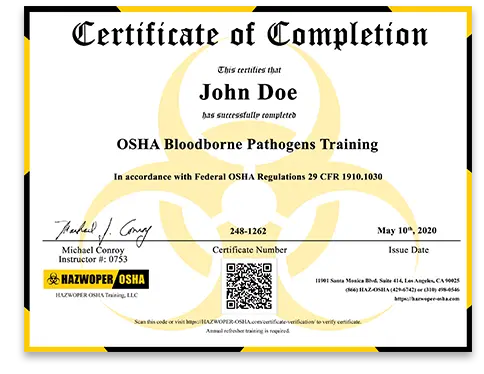
OSHA Bloodborne Pathogens Training course is designed to provide a basic understanding of OSHA’s Bloodborne Pathogens Standard (29 CFR 1910.1030), its scope, bloodborne diseases, their modes of transmission and prevention, and other pertinent information.
Bloodborne pathogens are infectious microorganisms in human blood that can cause disease in humans. These pathogens are transmitted from one infected individual to another through blood and other potentially infectious materials (OPIM). These pathogens include (but are not limited to) hepatitis B virus (HBV), hepatitis C virus (HCV), and human immunodeficiency virus (HIV).
OSHA’s bloodborne pathogens standard prescribes guidelines and safeguards to protect workers who are exposed to health hazards related to bloodborne pathogens. Furthermore, the Needlestick Safety and Prevention Act of 2000 modified OSHA’s Bloodborne Pathogens standard by requiring employers to identify, evaluate, and implement safer medical devices, such as needleless systems and sharps with engineered sharps protections. The Act also mandated additional requirements for maintaining a sharps injury log and for the involvement of non-managerial healthcare workers in identifying, evaluating, and choosing effective engineering and work practice controls.
The bloodborne pathogens standard applies to workers in many occupations, including first responders, housekeeping personnel, nurses and other healthcare personnel, laundry personnel, and many other workers who may encounter blood or OPIM in occupational settings.
Learning Objectives
The core objective of the OSHA Bloodborne Pathogens Training is to provide a basic understanding of OSHA’s Bloodborne Pathogens Standard (29 CFR 1910.1030) and its regulatory requirements that help protect workers from the health hazards associated with occupational exposure to blood and other potentially infectious materials (OPIM).
Course Objectives
After completion of the OSHA Bloodborne Pathogens Training course, the learner will be able to:
- Understand the purpose of OSHA’s Bloodborne Pathogens Standard and the Needlestick Safety and Prevention Act;
- Understand what a “pathogen” is and enlist its various types;
- Explain the modes of transmission of bloodborne infectious diseases and the related preventive measures;
- List the elements of an effective exposure control plan to prevent and minimize exposure to blood and OPIM;
- Understand the importance of using appropriate personal protective equipment (PPE) in the occupational settings;
- Summarize guidelines related to administration of the Hepatitis B vaccination series;
- Explain procedures related to post-exposure evaluation and follow-up; and
- Understand the step-by-step procedure for cleaning up a biological spill in the workplace.
Syllabus
This OSHA Bloodborne Pathogens Training course consists of 5 lessons. Students are required to take each lesson in sequential order as listed below.
Course Content
LESSONS
OSHA Bloodborne Pathogens Training: Introduction
- Lesson 1: Introduction to Bloodborne Pathogens –This lesson will provide in-depth details on OSHA’s bloodborne pathogens standard and its scope as well as the purpose of the Needlestick Safety and Prevention Act. The lesson will also explain what a pathogen is, and examine the four main types – virus, bacteria, fungi, parasites.
- Lesson 2: Bloodborne Infectious Diseases –This lesson will focus on providing learners with in-depth details about modes of transmission of bloodborne pathogens in occupational settings, define hepatitis and its types as well as symptoms and preventive measures to be adopted. HIV/AIDS, transmission methods, and symptoms will also be discussed.
- Lesson 3: Exposure Control Plan –This lesson will provide details of a written exposure control plan for occupational exposure to bloodborne pathogens as required by OSHA. The lesson will also describe the various exposure control strategies such as engineering controls and the appropriate use of personal protective equipment (PPE) that can be used to prevent and minimize employee exposure to bloodborne pathogens in the workplace.
- Lesson 4: Vaccination and Post-Exposure Follow-up – This lesson will deliver a basic understanding of an employer’s Hepatitis B vaccination program, summarize the guidelines to administer the Hepatitis B vaccination series, and focus on the procedures to follow in case of an exposure incident and the relevant follow-up guidelines.
- Lesson 5: Emergency Response and Training – This last lesson will outline a generic emergency response plan for biological spills in the workplace and explain the procedures for storage and transport of biohazard wastes. The lesson will guide learners on OSHA’s training requirements for workers exposed to blood and OPIM, and OSHA’s recordkeeping requirements related to bloodborne pathogens.
This OSHA Bloodborne Pathogens Training course is designed by OSHA Certified Outreach Trainers and is updated and reviewed as soon as new requirements or regulations are released by OSHA, EPA, DOT, and other regulatory agencies. The course meets and exceeds the compliance requirements of OSHA 29 CFR 1910.1030 regulations.

Training Requirements
There are no prerequisites for the OSHA Bloodborne Pathogens Training course.
Course Completion Certification
Once the course is completed, you will immediately be able to download, print, or save your OSHA Bloodborne Pathogens Training Certificate in PDF format.